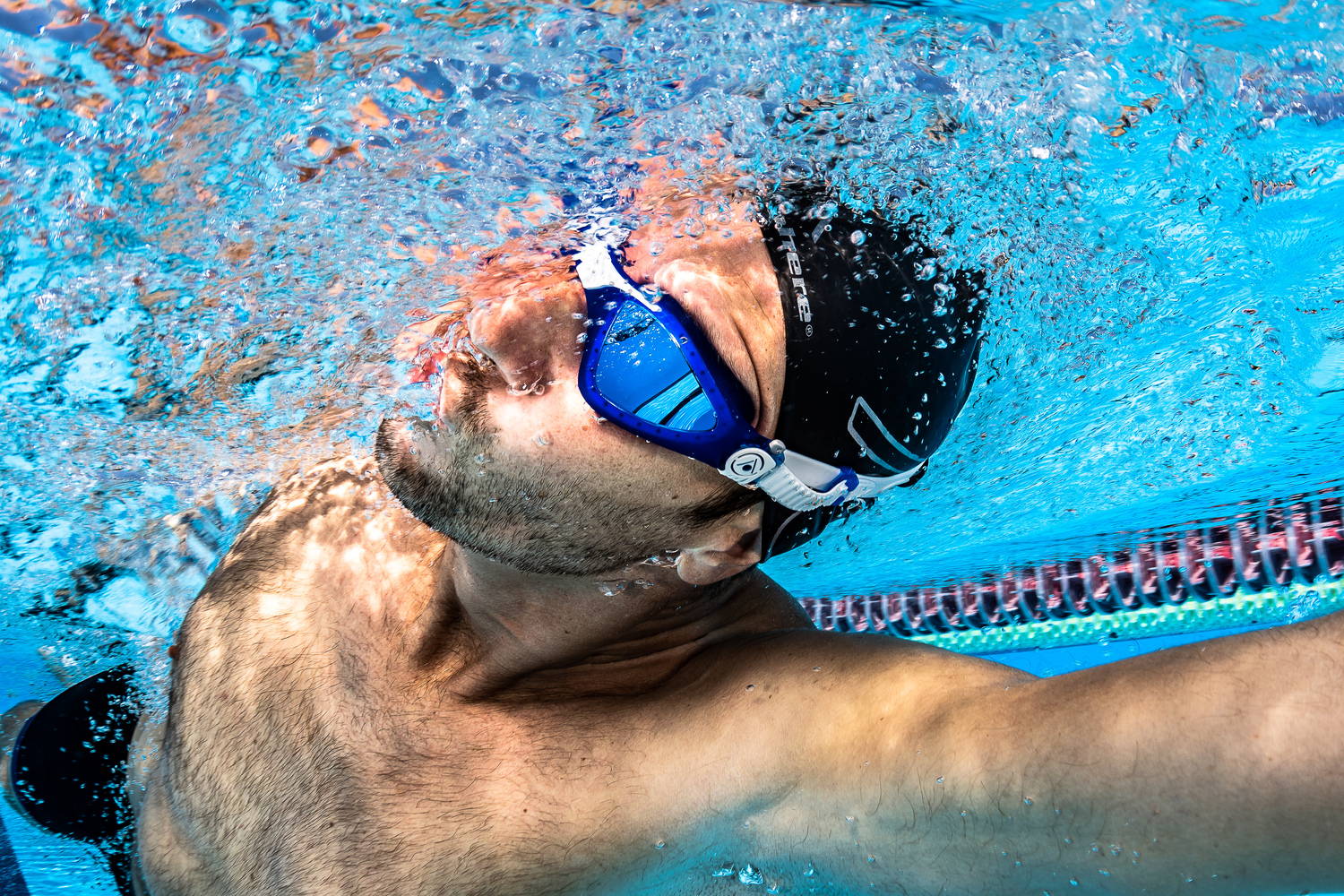Try different, not harder. Dieses Motto ist für ein gutes Techniktraining der Schlüsselsatz. Um sich zu verbessern, muss man wagen, Bewegungen zu verändern und Neues auszuprobieren. Auch wenn es zu Beginn schwer scheint – erfreulicherweise geht dadurch, gerade beim Kraulschwimmen am Ende vieles sehr viel leichter. Deshalb wagen wir heute Veränderungen. Wir verraten, was die „Alexandertechnik“ ist und wie sie euch schneller macht.
Herr Alexander, genauer gesagt, Frederick Matthias Alexander, war nicht etwa Sportler, sondern Schauspieler. Auch ist es nicht verwunderlich, wenn ihr den Herren immer noch nicht kennt, denn er lebte im 19. Jahrhundert.
Was wir damit in einem Artikel über Schwimmtechnik wollen, fragt ihr euch? Nun, Herr Alexander war unseres Wissens zwar nicht bekannt für seine überragenden Schwimmleistungen, dennoch wirkte und forschte er in Bereichen, die besonders im Schwimmen eine Schlüsselrolle innehaben: der Atmung, sowie der Bewegung und Bewegungssteuerung!
Zu den triathlon.de Schwimmseminaren
Gewohnheiten erkennen, Fehler analysieren und ändern
Für Frederick Alexander waren alle geistigen, seelischen und körperlichen Prozesse eines Menschen miteinander verbunden. Das bedeutet nichts anderes, als dass der Mensch Gewohnheiten und Muster entwickelt, die sich dank der Gewohnheit richtig anfühlen, mitunter jedoch nicht förderlich sind.
Es gilt also, tägliche Prozesse, Routinen oder Bewegungsabläufe zu hinterfragen und zu entscheiden, ob sie tatsächlich „richtig“ sind, oder ob sie nur der Gewohnheit wegen so ausgeführt werden. Findet man Muster, die verbesserungswürdig erscheinen, dann lassen sich diese nämlich ändern.
Anweisungen denken, Anweisungen befolgen
Zunächst gilt es ganz bewusst den äußeren oder inneren Reiz, der einen zum Handeln bewegt, zu analysieren. Dann diesen zu unterdrücken und bewusst eine neue Anweisung zu formulieren. Eine Anweisung stellt die Gedanken dar, die eine neue Bewegung beschreiben und uns dann ausführen lassen. Neue und ganz unbekannte Bewegungsabläufe können so eingeübt werden. Wichtig: Eine neue Bewegung fängt im Kopf an.
Kopf, Hals und Rumpf als zentrale Elemente
Herr Alexander sah Kopf, Hals und Rumpf als zentrale Elemente an, die es zu steuern und in Einklang zu bringen galt. Gerade beim Schwimmen spielen diese Elemente auch eine tragende Rolle. Denn der Kopf balanciert am Ende der Halswirbelsäule, die die mobile Verbindung zwischen Kopf und dem Rest des Rückens darstellt. Je lockerer wir den Kopf lassen können, desto weniger verspannt sich unsere Nackenmuskulatur, desto freier bleibt der beweglichste Teil unseres Rückens und umso einfacher werden alle Bewegungen. Zudem steuert die Kopfposition unseren Körper im Wasser.
Die Macht der Gewohnheit durchbrechen
Es ist ganz einfach. Versuche dich im Wasser abzustoßen und zu gleiten (das geht gerade im Kinderbecken sehr gut). Genieße das Gleiten. Versuche mit einem Abstoß möglichst weit zu kommen. Wiederhole die Übung mit geschlossenen Augen und beobachte dich selbst. Verändert sich etwas? Was passiert bei unterschiedlichen Kopf-/Armhaltungen? Der Blick ist immer Richtung Beckenboden gerichtet – und das Schweben ist plötzlich ganz leicht.
Wohlfühlen und Grenzen verschieben
Das Ziel der Übung ist es, sich dabei so wohl wie möglich zu fühlen. Wenn das klappt, können die Beine zusätzlich eingesetzt werden. Nun kommt die Herausforderung. Wir starten in Bauchlage, schweben, kommen an die Wasseroberfläche und machen etwas Beinschlag. Jetzt mit einem halben Armzug eine 90° Drehung einleiten und den ganzen Körper auf die Seite legen, die Beine dürfen weiterarbeiten.
In dieser Position, Beinschlag auf der Seite, sollte man gut atmen können. Der bodennahe Arm ist ausgestreckt, der Arm oben liegt locker auf der Körperseite. Die Herausforderung besteht darin, den Kopf nicht anzuheben, sondern schön parallel entlang der Wasseroberfläche zu schauen, sich zu entspannen und wohl zu fühlen.
Und wie wird geatmet?
Wir verändern unsere Wasserlage nicht, vielmehr drehen wir den Kopf einfach entlang der Körperachse Richtung Schulter. Wer den Kopf anhebt, wird schnell merken, dass der ganze Körper absinkt. Legt man den Kopf wieder auf den langen Arm entspannt sich die Situation und die Wasserlage wird wieder angenehm. Keine Sorge, diese Übung ist eine der Schwersten im Schwimmen, aber wenn man das kann, dann ist der Rest ein Kinderspiel. Es lohnt sich daher hier etwas Zeit zu investieren.
Ein kleiner Tipp
Man kann diese Übung auch aus der Rückenlage beginnen, dann hat man schon einmal gut eingeatmet und kann sich langsam so weit drehen wie es angenehm ist. Wenn das gut klappt, die gleiche Übung aus der Bauchlage heraus probieren. Kurze Flossen können helfen, denn sie geben dem Körper eine höhere Grundgeschwindigkeit. Dadurch wird die Wasserlage insgesamt besser und die Übung einfacher.
Für das normale Kraulschwimmen hilft uns diese Übung nicht nur in Sachen (Selbst-)Sicherheit und Rotation, sondern auch in Bezug auf eine effektive, weil bewegungsarme Atemtechnik. Um auf Herrn Alexander zurückzukommen: es hilft beim Atmen daran zu denken, dass die Badekappe im Wasser bleiben soll. Denn nur dann bleibt die Wasserlage stabil und das Tempo ungebremst.
Trainings-Tipp der Woche
200 bis 500 Meter locker Einschwimmen, gerne auch in Brust und Rücken
10 Mal Abstoßen und gleiten, auf den Boden schauen, die Augen schließen
10 x 2 Bahnen (eine Bahn Beinschlag in Seitlage, eine Bahn Kraul und dann die Seite wechseln)
5 x 200 Meter Kraul zur Anwendung des Gelernten





















1 Kommentar
Kathrin
Wie wunderbar, dass hier FM Alexander erwähnt wird. Er war zwar nicht bekannt für seine Schwimmtechnik, aber er hat Steven Shaw inspiriert und beeinflusst. Auf Basis der Alexander Technik hat Steven Shaw die 4 Schwimmstile weiterentwickelt und die Shaw Methode begründet. Dabei wurden die Prinzipien der Alexander Technik auf die Schwimmbewegungen übertragen. Das Ergebnis: Im Mittelpunkt steht die Körperausrichtung, insbesondere die Verbindung von Kopf, Nacken und Rücken, die zu mehr Effizienz und Leichtigkeit führt. Steven Shaw, selbst ehemaliger Leistungsschwimmer, entwickelte diese Methode, nachdem er mit Nacken- und Rückenschmerzen zu kämpfen hatte. Mithilfe der Alexander-Technik fand er einen Weg, schmerzfrei zu schwimmen.
Somit ein fettes DANKE an Annette Gasper für diesen wertvollen Artikel!